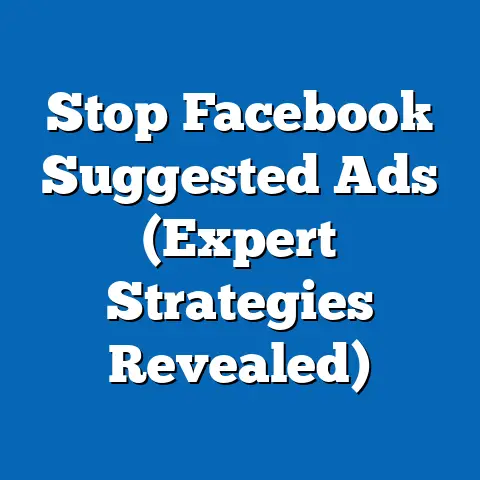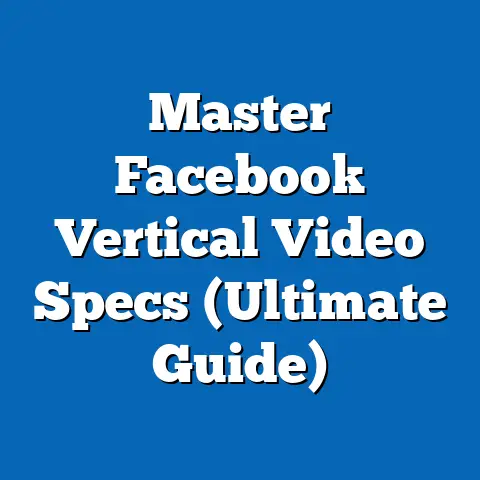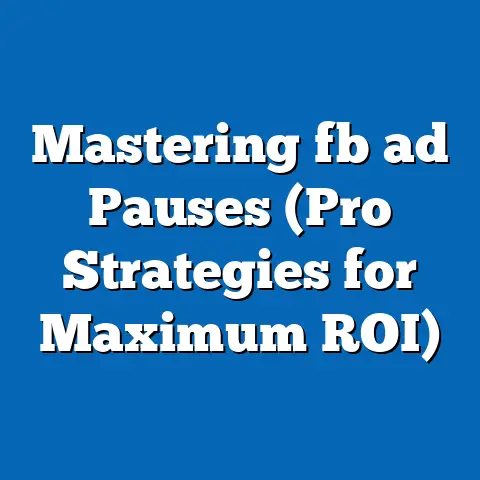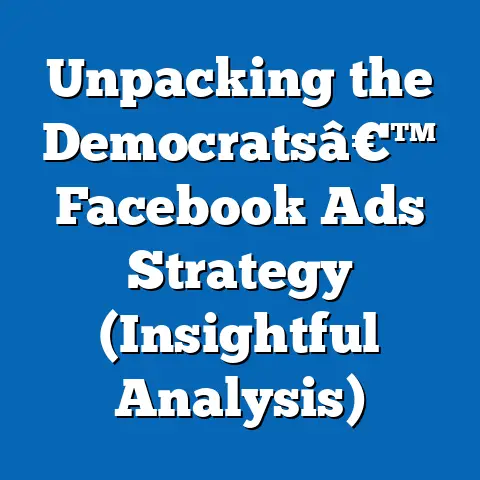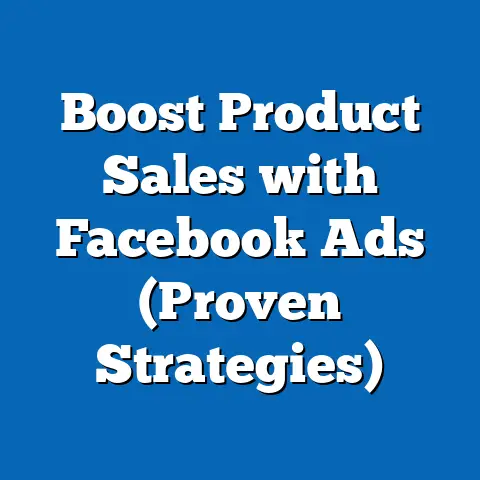Master Facebook Ads Specs 2025 (Essential Insights Unveiled)
Life in the 21st century feels like a constant juggling act. We’re bombarded with information, deadlines, and demands, leaving little time for anything that doesn’t immediately grab our attention. As individuals and businesses, we’re all fighting for a piece of that attention pie. And in this chaotic landscape, effective advertising becomes absolutely crucial.
Facebook, despite the rise of newer platforms, remains a titan in the social media world. Its massive user base and sophisticated targeting capabilities make it a powerful tool for businesses of all sizes. But simply throwing money at Facebook ads isn’t enough. To truly succeed, you need to master the art of crafting impactful campaigns that cut through the noise and resonate with your target audience. And that starts with understanding and adhering to Facebook Ads specifications.
Why are these specs so important? Think of it like this: you wouldn’t build a house without blueprints, would you? Facebook Ads specifications are your blueprints for creating effective, engaging, and ultimately, profitable ad campaigns. They dictate everything from image sizes to text limits, ensuring your message is delivered in the most optimal way possible. In this guide, I’ll take you through the essential Facebook Ads specifications you need to know for 2025, providing insights and actionable tips to help you create campaigns that truly shine.
The Evolution of Facebook Ads
Facebook Ads have come a long way since their humble beginnings. I remember when they were just simple text-based ads tucked away in the sidebar, barely noticeable amidst the flurry of status updates and cat videos. Back then, targeting was rudimentary, and the concept of “engagement” was still relatively new.
Over the years, Facebook Ads have evolved dramatically, mirroring the platform’s own growth and the changing landscape of digital marketing. We’ve seen the introduction of image ads, video ads, carousel ads, and a whole host of other formats, each with its own unique set of specifications. Targeting options have become increasingly sophisticated, allowing advertisers to pinpoint their ideal audience with laser-like precision. And the focus has shifted from simply generating impressions to driving meaningful engagement and conversions.
Here’s a brief timeline of some key milestones:
- 2004: Facebook launches, initially without any advertising.
- 2007: Facebook introduces its first advertising platform, featuring basic text-based ads.
- 2009: Facebook introduces the “Like” button, revolutionizing user engagement.
- 2012: Facebook acquires Instagram, expanding its advertising reach and capabilities.
- 2013: Facebook launches Custom Audiences, allowing advertisers to target users based on their own data.
- 2015: Facebook introduces video ads, marking a significant shift towards visual content.
- 2017: Facebook rolls out Collection ads, offering a more immersive shopping experience.
- 2019: Facebook introduces ad targeting based on interests and behaviors.
- 2021: Facebook rebrands to Meta, signaling a shift towards the metaverse.
Looking ahead to 2025, we can expect even more changes in the Facebook advertising landscape. The rise of AI, augmented reality, and evolving user behavior will all play a significant role in shaping the future of Facebook Ads. This means that advertisers need to be proactive, continuously learning and adapting their strategies to stay ahead of the curve. This includes understanding how specifications will evolve to accommodate new technologies and advertising formats.
Takeaway: Facebook Ads have undergone a significant transformation since their inception. Staying informed about these changes and anticipating future trends is crucial for success.
Key Specifications for 2025
Now, let’s dive into the nitty-gritty of Facebook Ads specifications for 2025. These are the guidelines you need to follow to ensure your ads are displayed correctly, reach the right audience, and achieve your desired results.
Ad Formats
Facebook offers a variety of ad formats, each with its own unique strengths and weaknesses. Understanding these formats and their specific requirements is essential for creating effective campaigns.
-
Image Ads: These are the simplest and most common type of Facebook ad. They consist of a single image, headline, description, and call-to-action button.
- Image Dimensions: 1200 x 628 pixels (recommended)
- Aspect Ratio: 1.91:1
- File Type: JPG or PNG
- Pro Tip: Use high-quality images that are visually appealing and relevant to your target audience. Avoid using images with excessive text, as this can negatively impact your ad’s performance.
-
Video Ads: Video ads are a powerful way to capture attention and tell your brand’s story. They can be used to showcase products, share testimonials, or simply entertain your audience.
- Video Dimensions: 1280 x 720 pixels (recommended)
- Aspect Ratio: 16:9, 1:1, 4:5, 9:16
- File Type: MP4 or MOV
- Video Length: Up to 240 minutes
- Pro Tip: Optimize your video for mobile viewing by using vertical or square aspect ratios. Add captions to your video to make it accessible to viewers who are watching without sound.
-
Carousel Ads: Carousel ads allow you to showcase multiple images or videos within a single ad unit. This is a great way to highlight different products, features, or benefits.
- Image Dimensions: 1080 x 1080 pixels (recommended)
- Aspect Ratio: 1:1
- File Type: JPG or PNG
- Video Dimensions: 1080 x 1080 pixels (recommended)
- Aspect Ratio: 1:1
- File Type: MP4 or MOV
- Number of Cards: 2-10
- Pro Tip: Use compelling visuals and concise descriptions to entice users to swipe through your carousel. Tell a story or highlight different aspects of your product or service in each card.
-
Collection Ads: Collection ads are designed for e-commerce businesses. They feature a cover image or video followed by a selection of products. When users click on a collection ad, they are taken to a full-screen Instant Experience where they can browse and purchase products.
- Image Dimensions: 1200 x 628 pixels (recommended)
- Aspect Ratio: 1.91:1
- File Type: JPG or PNG
- Video Dimensions: 1280 x 720 pixels (recommended)
- Aspect Ratio: 16:9, 1:1, 4:5, 9:16
- File Type: MP4 or MOV
- Pro Tip: Use high-quality visuals and compelling product descriptions to showcase your products. Optimize your Instant Experience for mobile viewing and make it easy for users to browse and purchase products.
Image Ads: These are the simplest and most common type of Facebook ad. They consist of a single image, headline, description, and call-to-action button.
- Image Dimensions: 1200 x 628 pixels (recommended)
- Aspect Ratio: 1.91:1
- File Type: JPG or PNG
- Pro Tip: Use high-quality images that are visually appealing and relevant to your target audience. Avoid using images with excessive text, as this can negatively impact your ad’s performance.
Video Ads: Video ads are a powerful way to capture attention and tell your brand’s story. They can be used to showcase products, share testimonials, or simply entertain your audience.
- Video Dimensions: 1280 x 720 pixels (recommended)
- Aspect Ratio: 16:9, 1:1, 4:5, 9:16
- File Type: MP4 or MOV
- Video Length: Up to 240 minutes
- Pro Tip: Optimize your video for mobile viewing by using vertical or square aspect ratios. Add captions to your video to make it accessible to viewers who are watching without sound.
Carousel Ads: Carousel ads allow you to showcase multiple images or videos within a single ad unit. This is a great way to highlight different products, features, or benefits.
- Image Dimensions: 1080 x 1080 pixels (recommended)
- Aspect Ratio: 1:1
- File Type: JPG or PNG
- Video Dimensions: 1080 x 1080 pixels (recommended)
- Aspect Ratio: 1:1
- File Type: MP4 or MOV
- Number of Cards: 2-10
- Pro Tip: Use compelling visuals and concise descriptions to entice users to swipe through your carousel. Tell a story or highlight different aspects of your product or service in each card.
Collection Ads: Collection ads are designed for e-commerce businesses. They feature a cover image or video followed by a selection of products. When users click on a collection ad, they are taken to a full-screen Instant Experience where they can browse and purchase products.
- Image Dimensions: 1200 x 628 pixels (recommended)
- Aspect Ratio: 1.91:1
- File Type: JPG or PNG
- Video Dimensions: 1280 x 720 pixels (recommended)
- Aspect Ratio: 16:9, 1:1, 4:5, 9:16
- File Type: MP4 or MOV
- Pro Tip: Use high-quality visuals and compelling product descriptions to showcase your products. Optimize your Instant Experience for mobile viewing and make it easy for users to browse and purchase products.
Text Limits
Facebook has character limits for headlines, descriptions, and primary text. Staying within these limits is crucial for ensuring your message is displayed correctly and doesn’t get cut off.
- Headline: 25 characters (recommended)
- Description: 30 characters (recommended)
- Primary Text: 125 characters (recommended)
I’ve personally struggled with these limitations in the past. It can be challenging to convey your message effectively within such a limited space. However, it forces you to be concise and focus on the most important information.
Pro Tip: Use strong, attention-grabbing headlines that clearly communicate your value proposition. Craft concise and engaging descriptions that entice users to learn more. Use the primary text to highlight key benefits and features. A/B test different versions of your ad copy to see what resonates best with your target audience.
Targeting Options
Facebook’s targeting options are incredibly powerful, allowing you to reach specific demographics, interests, and behaviors. Understanding these options is crucial for ensuring your ads are seen by the right people.
- Demographic Targeting: Target users based on age, gender, location, education, and other demographic factors.
- Interest Targeting: Target users based on their interests, hobbies, and activities.
- Behavior Targeting: Target users based on their online behavior, such as purchase history, website visits, and app usage.
- Custom Audiences: Target users based on your own data, such as email lists, website visitors, and app users.
- Lookalike Audiences: Target users who are similar to your existing customers or website visitors.
In 2025, we can expect even more sophisticated targeting options, driven by AI and machine learning. This will allow advertisers to reach their ideal audience with even greater precision.
Pro Tip: Experiment with different targeting options to see what works best for your business. Use a combination of demographic, interest, and behavior targeting to reach a broad but relevant audience. Create custom audiences and lookalike audiences to target your most valuable customers.
Call-to-Action Buttons
Call-to-action (CTA) buttons are essential for driving engagement and conversions. They tell users what you want them to do next, whether it’s visiting your website, making a purchase, or signing up for a newsletter.
Facebook offers a variety of CTA buttons, including:
- Learn More
- Shop Now
- Sign Up
- Download
- Book Now
- Contact Us
Pro Tip: Choose a CTA button that is relevant to your ad’s objective. Use clear and concise language that tells users exactly what they will get when they click on the button. A/B test different CTA buttons to see which ones perform best.
Ad Placement
Facebook Ads can be placed on Facebook itself, Instagram, and the Audience Network. Each placement has its own unique characteristics and requires different strategies.
- Facebook Feed: Ads appear in the user’s news feed, alongside posts from friends and family.
- Facebook Right Column: Ads appear in the right column of the Facebook website. (Mostly desktop users)
- Instagram Feed: Ads appear in the user’s Instagram feed, alongside posts from other users.
- Instagram Stories: Ads appear between Instagram stories.
- Audience Network: Ads appear on third-party websites and apps that are part of the Facebook Audience Network.
Pro Tip: Choose ad placements that are relevant to your target audience and ad objective. Optimize your ads for each placement to ensure they are displayed correctly and effectively. Consider using automatic placements to let Facebook optimize your ad delivery across all placements.
Takeaway: Mastering Facebook Ads specifications is crucial for creating effective campaigns. Pay attention to ad formats, text limits, targeting options, call-to-action buttons, and ad placement to maximize your results.
Insights from Successful Campaigns
Let’s take a look at some real-world examples of successful Facebook ad campaigns that effectively utilized the specifications discussed above.
Example 1: Dollar Shave Club – Video Ad
Dollar Shave Club’s viral video ad is a classic example of how to use humor and compelling storytelling to capture attention and drive sales. The ad features the company’s founder, Michael Dubin, delivering a witty and irreverent pitch for their razor subscription service.
- Key Learning Points:
- Use humor to engage your audience and make your brand memorable.
- Tell a story that resonates with your target audience.
- Clearly communicate your value proposition.
- Use a strong call-to-action to drive conversions.
- Use humor to engage your audience and make your brand memorable.
- Tell a story that resonates with your target audience.
- Clearly communicate your value proposition.
- Use a strong call-to-action to drive conversions.
Example 2: Airbnb – Image Ad
Airbnb’s image ads showcase unique and desirable properties in various locations around the world. The ads use high-quality images and compelling descriptions to entice users to book their next vacation rental.
- Key Learning Points:
- Use high-quality visuals that are visually appealing and relevant to your target audience.
- Highlight the unique benefits and features of your product or service.
- Target your ads to users who are likely to be interested in your product or service.
- Use a clear and concise call-to-action to drive bookings.
- Use high-quality visuals that are visually appealing and relevant to your target audience.
- Highlight the unique benefits and features of your product or service.
- Target your ads to users who are likely to be interested in your product or service.
- Use a clear and concise call-to-action to drive bookings.
Example 3: Warby Parker – Carousel Ad
Warby Parker’s carousel ads showcase a variety of their stylish eyeglasses. The ads use high-quality images and concise descriptions to highlight the different styles and features of their glasses.
- Key Learning Points:
- Use carousel ads to showcase multiple products or features.
- Use high-quality visuals and concise descriptions.
- Tell a story or highlight different aspects of your product or service in each card.
- Use a strong call-to-action to drive sales.
- Use carousel ads to showcase multiple products or features.
- Use high-quality visuals and concise descriptions.
- Tell a story or highlight different aspects of your product or service in each card.
- Use a strong call-to-action to drive sales.
These examples demonstrate that mastering Facebook Ads specifications, combined with creative content and strategic targeting, can lead to significant success.
Takeaway: Study successful Facebook ad campaigns to learn from their strategies and tactics. Pay attention to how they utilize ad formats, text limits, targeting options, and call-to-action buttons.
The Future of Facebook Advertising
Looking beyond 2025, the future of Facebook advertising is likely to be shaped by several key trends and advancements in technology.
- Augmented Reality (AR) Ads: AR ads will allow users to interact with products in a virtual environment, providing a more immersive and engaging shopping experience.
- Artificial Intelligence (AI) Driven Targeting: AI will be used to analyze user data and identify the most relevant audiences for your ads, leading to more effective targeting.
- Personalized Advertising: Ads will become increasingly personalized, tailored to the individual user’s interests and preferences.
- Voice Search Optimization: As voice search becomes more prevalent, advertisers will need to optimize their ads for voice queries.
- Metaverse Integration: Facebook’s shift towards the metaverse will likely lead to new advertising opportunities within virtual worlds.
These trends suggest that the future of Facebook advertising will be more immersive, personalized, and data-driven. Advertisers who are willing to embrace these changes and adapt their strategies will be best positioned for success.
Takeaway: Stay informed about the latest trends and advancements in technology to anticipate future changes in the Facebook advertising landscape.
Conclusion
In today’s fast-paced world, capturing and maintaining attention is more challenging than ever. Mastering Facebook Ads specifications is not just about following rules; it’s about understanding the fundamental principles of effective advertising. By adhering to these specifications, you can ensure your ads are displayed correctly, reach the right audience, and achieve your desired results.
Remember, the Facebook advertising landscape is constantly evolving. To stay ahead of the curve, you need to be proactive, continuously learning and adapting your strategies to the latest trends and advancements in technology. By doing so, you can effectively reach and engage your target audience amidst the noise of a fast-paced world, driving meaningful results for your business. So, embrace the challenge, master the specifications, and unlock the full potential of Facebook advertising!

